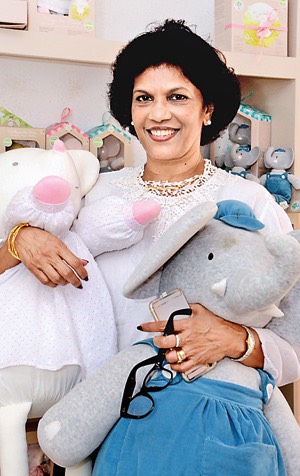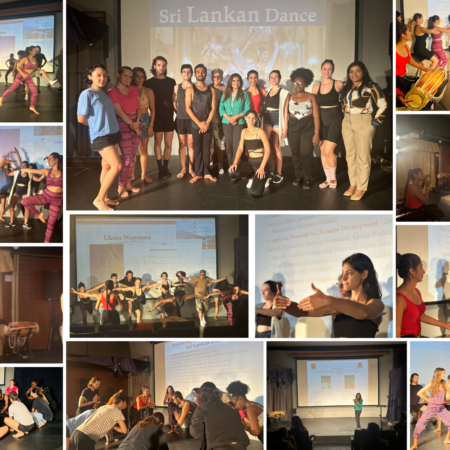BIYAGAMA: And here I was make-believing that God threw away the mould after he made me. This is something we all like to indulge in, feeding our ego like an obese child merrily stuffing his or her face with candy. But one look at the factory floor at DSL Lanka (Douglas and Sons) and my self-esteem was punctured rapidly for there were ranks and ranks of Alvins – a plush toy which is the brainchild of Mano Sheriff. She laughs when I tell her my bubble has been burst. Alvin the Aliya, or Elephant, is one half of the Meiya and Alvin toy collection which is cuddly and cute and is now widely sold in the US, Europe and Asia – and soon to be sold in Sri Lanka, the birth home.
“Meiya the Mouse came first. I had created this toy and Mothercare suggested Meiya should have a friend and that I should do a children’s book about them,” says Mano, managing director and CEO of DSL Lanka. A first-ever infant toy that combines soft textile and natural rubber the Meiya and Alvin collection is made for babies and toddlers. Mano, who pictures a world of innocence in which children can be who they are and where the purity of childhood is held sacred, has also done a storybook – A Day At The Park With Meiya And Alvin – which has been translated into seven languages including French, German, Spanish and Catalan.
Made at the BOI-approved company in Biyagama and launched two years ago, Meiya and Alvin has also been a big hit in the US where it went on sale last July. More than 150,000 pieces of the toys have been manufactured. Hundreds more were being made the day I discovered my ‘mould’ was still around. To be precise it is many moulds as a single mould can only be used 15 times before it is cast aside and liquid rubber is poured into a fresh one. Mano takes me on a guided tour of the factory – they have another in Galle both of which employs around 900 workers – showing how her idea is born.
 Returning from Australia
Returning from AustraliaIt all began back in 1991 – the year she, her husband and two children, decided to move back from Australia where they had emigrated two years earlier. “I’m a chartered accountant by profession and when we were living in Australia (1989-90), I worked as a finance manager at a toy company,” Mano relates. Fed up with life in not-so green pastures, the family returned home and Mano tied up with Saroj Perera, chairman of Douglas and Sons. “I was working for an American company which said it would like to buy toys made in Sri Lanka. So I started my own buying company and DSL was the local collaborator who was in partnership with a Korean company.
From the inception I was involved in this company giving orders, and buying and exporting to the States. We were making Barrington Bear, Peter the Rabbit among other popular toys.” In 2001 the Koreans moved out and DSL came under the full control of Mr. Perera. In 2006 he invited Mano to join him as a partner with the assurance that the orders would continue. A few years after becoming a partner, Mano decided it was time to start her own brand of toys and Bonnika was born styled on a doll owned by her grandmother. “I still have this doll at home. It is made of porcelain and was quite a big doll, around 18 inches. We were only allowed to make dresses for it.
I never thought then that one day I would be making dolls and stuffed toys for children all over the world.” Inspired by the porcelain doll, Bonnika a beautifully crafted rag doll was the first homegrown product from DSL and it rolled off the production lines in 2012. It was special as rubber and fabric was used, a combination never used before in the world of dolls which had always relied on porcelain and ceramic. This has led today to Meiya and Alvin, plush toys, each with its rubber head and stuffed bodies, making it easy for little hands to grip.
Alvin in the oven
My tour of the factory floor begins with the plastic moulds where the rubber heads of Meiya and Alvin are made. Large ovens bake the moulds for three hours before they are taken out and left to dry for a day. The heads, with the frayed edges shaved off, are then taken to a dehumidifying room where it is kept for two weeks so that the smell of rubber wears off. The heads are then spray and hand-painted with every minute detail etched. At another end of the production line, stuffing made out of recycled polyester from PET bottles is hosed into the bodies of Meiya and Alvin. It takes 60 days from start to finish. Each piece retails around US$18. The price is worth it for mothers around the world for their babies love it.
DSL manufactures around 250,000 pieces of toys every month yet Mano feels a lot remains to be done. She explains the split is 70-30 at the moment – 70 OEM (buyers branding and selling the toys under their own name) while only 30 per cent are their own brands (Meiya and Alvin plus Bonnika). The target is within the next two years to make it an even playing field, 50-50. Her goals are quite attainable as the world is moving away from the plastic Barbie Doll to more natural products like those made in Biyagama.
The horror stories coming out of China – a few years ago American companies had to recall all their dolls made in China as they were found to have excessive amounts of lead in their paint – has also helped DSL. “We are an environmentally- friendly factory, very green. But it is still tough to match the pricing out of China. We however have an edge as a lot of buyers love the fact that the toys are made in Sri Lanka. They know our factories are not sweat shops and that our workers are happy and have a smile on their face. Although our prices may be higher, they still come because of our ethical manufacturing standards,” says Mano. And of course because of Meiya and Alvin. Who can resist an Alvin?






















